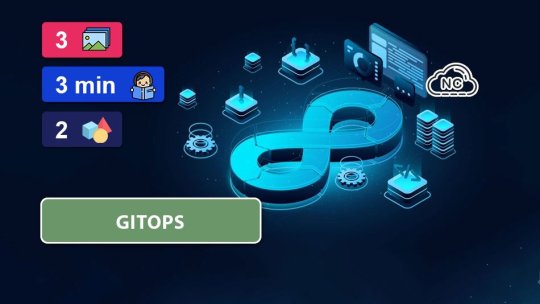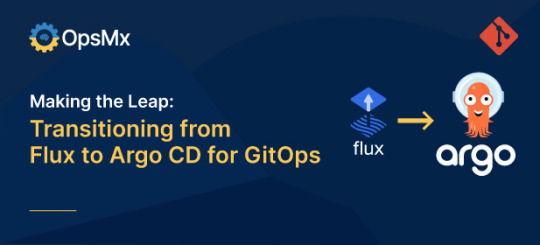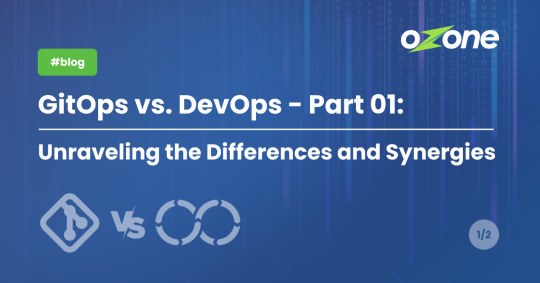#GitOps
Explore tagged Tumblr posts
Text
What is Argo CD? And When Was Argo CD Established?

What Is Argo CD?
Argo CD is declarative Kubernetes GitOps continuous delivery.
In DevOps, ArgoCD is a Continuous Delivery (CD) technology that has become well-liked for delivering applications to Kubernetes. It is based on the GitOps deployment methodology.
When was Argo CD Established?
Argo CD was created at Intuit and made publicly available following Applatix’s 2018 acquisition by Intuit. The founding developers of Applatix, Hong Wang, Jesse Suen, and Alexander Matyushentsev, made the Argo project open-source in 2017.
Why Argo CD?
Declarative and version-controlled application definitions, configurations, and environments are ideal. Automated, auditable, and easily comprehensible application deployment and lifecycle management are essential.
Getting Started
Quick Start
kubectl create namespace argocd kubectl apply -n argocd -f https://raw.githubusercontent.com/argoproj/argo-cd/stable/manifests/install.yaml
For some features, more user-friendly documentation is offered. Refer to the upgrade guide if you want to upgrade your Argo CD. Those interested in creating third-party connectors can access developer-oriented resources.
How it works
Argo CD defines the intended application state by employing Git repositories as the source of truth, in accordance with the GitOps pattern. There are various approaches to specify Kubernetes manifests:
Applications for Customization
Helm charts
JSONNET files
Simple YAML/JSON manifest directory
Any custom configuration management tool that is set up as a plugin
The deployment of the intended application states in the designated target settings is automated by Argo CD. Deployments of applications can monitor changes to branches, tags, or pinned to a particular manifest version at a Git commit.
Architecture
The implementation of Argo CD is a Kubernetes controller that continually observes active apps and contrasts their present, live state with the target state (as defined in the Git repository). Out Of Sync is the term used to describe a deployed application whose live state differs from the target state. In addition to reporting and visualizing the differences, Argo CD offers the ability to manually or automatically sync the current state back to the intended goal state. The designated target environments can automatically apply and reflect any changes made to the intended target state in the Git repository.
Components
API Server
The Web UI, CLI, and CI/CD systems use the API, which is exposed by the gRPC/REST server. Its duties include the following:
Status reporting and application management
Launching application functions (such as rollback, sync, and user-defined actions)
Cluster credential management and repository (k8s secrets)
RBAC enforcement
Authentication, and auth delegation to outside identity providers
Git webhook event listener/forwarder
Repository Server
An internal service called the repository server keeps a local cache of the Git repository containing the application manifests. When given the following inputs, it is in charge of creating and returning the Kubernetes manifests:
URL of the repository
Revision (tag, branch, commit)
Path of the application
Template-specific configurations: helm values.yaml, parameters
A Kubernetes controller known as the application controller keeps an eye on all active apps and contrasts their actual, live state with the intended target state as defined in the repository. When it identifies an Out Of Sync application state, it may take remedial action. It is in charge of calling any user-specified hooks for lifecycle events (Sync, PostSync, and PreSync).
Features
Applications are automatically deployed to designated target environments.
Multiple configuration management/templating tools (Kustomize, Helm, Jsonnet, and plain-YAML) are supported.
Capacity to oversee and implement across several clusters
Integration of SSO (OIDC, OAuth2, LDAP, SAML 2.0, Microsoft, LinkedIn, GitHub, GitLab)
RBAC and multi-tenancy authorization policies
Rollback/Roll-anywhere to any Git repository-committed application configuration
Analysis of the application resources’ health state
Automated visualization and detection of configuration drift
Applications can be synced manually or automatically to their desired state.
Web user interface that shows program activity in real time
CLI for CI integration and automation
Integration of webhooks (GitHub, BitBucket, GitLab)
Tokens of access for automation
Hooks for PreSync, Sync, and PostSync to facilitate intricate application rollouts (such as canary and blue/green upgrades)
Application event and API call audit trails
Prometheus measurements
To override helm parameters in Git, use parameter overrides.
Read more on Govindhtech.com
#ArgoCD#CD#GitOps#API#Kubernetes#Git#Argoproject#News#Technews#Technology#Technologynews#Technologytrends#govindhtech
2 notes
·
View notes
Text

2 notes
·
View notes
Text
GitOps vs DevOps vs DevSecOps: Key Differences and Best Practices
Explore the key differences between GitOps vs DevOps vs DevSecOps, and understand their best practices for modern software development. Learn how each approach enhances automation, security, and collaboration in CI/CD pipelines.

1 note
·
View note
Text
What is the difference between GitOps and DevOps.
Cual es la Diferencia entre GitOps y DevOps.
�� https://blog.nubecolectiva.com/cual-es-la-diferencia-entre-gitops-y-devops/

#software development#web development#100daysofcode#developerlife#developers#devs#web developers#worldcode#developers & startups#backenddevelopment#frontendev#frontenddevelopment#frontend developer#gitops#devops#software
0 notes
Text
5 GitOps Tools that you need to know!
5 GitOps Tools that you need to know! @vexpert @portainerio #vmwarecommunities #kubernetes #docker #dockercontainers #gitops #devops #argocd #fluxcd #portainer #homeserver #homelab
I have been getting hugely into GitOps in the home lab lately and carrying those skillings into production environments. GitOps is a methodology that focuses on deployments being sourced from a git repo. Using GitOps you can encapsulate everything in your git repo and then make sure your apps are applied to your environment in a declarative way. Let’s look at 5 tools that you need to know for…
0 notes
Text
Tech Links of the Month September 2024
Automate SAP cloud testing
Revolutionizing Software Testing: The Power of AI in Action
Grafana vs. Prometheus: Comparison and Differences
6 GitOps Tools You Should Know About in 2024
1 note
·
View note
Text
GitOps: Introduction
How does GitOps work? GitOps is an innovative approach where Git serves as the central source for managing infrastructure and applications. By applying Git principles to the operations side of […]
Read the full Article https://activedirectoryfaq.com/2024/08/gitops-introduction/
#DevOps, #GitOps
0 notes
Text
A Comprehensive Guide to GitOps: Benefits, Challenges, and Core Principles

Although often seen as a new approach, GitOps has been a foundational strategy in the tech industry for infrastructure automation, continuous deployment, and system administration. According to a CNCF survey, over 60% of respondents have used GitOps methods and tools for more than a year. This widespread adoption highlights GitOps' reliability and effectiveness in managing complex systems and automating routine tasks. Let's explore GitOps further, focusing on its benefits and the reasons behind its growing popularity.
What Is GitOps?
GitOps (Git Operations) is an operational framework based on DevOps practices like CI/CD and version control, aimed at automating infrastructure and software deployment. It enables developers to store the desired state of their infrastructure and use it to automate operational tasks. GitOps is applied from the beginning of the development workflow through to deployment.
This approach is developer-centric, leveraging tools that developers are already familiar with, such as Git. It extends the use of Git beyond application code to include application configuration, infrastructure, and operational procedures.
Principles of GitOps
GitOps is grounded in a set of core principles that guide the management and operation of software systems. These principles include using automation tools to apply changes to the target environment, continuously synchronizing the system with the Git repository, and storing the desired state of the system declaratively in a Git repository. By adopting these practices, organizations can enhance the efficiency, reliability, and traceability of infrastructure and application configuration management. GitOps emphasizes using Git as the single source of truth for system state, aligning with other DevOps methodologies.
Benefits of GitOps
Efficiency and Automation: GitOps automates infrastructure and frequent deployments. With Git as the source of truth, processes are streamlined, manual work is minimized, and productivity is increased. Studies show that GitOps reduces lead times by empowering developers to work independently.
Transparency and Collaboration: GitOps uses Git repositories and pull requests for infrastructure changes, providing visibility, review, and auditing capabilities.
Reliability and Stability: By declaring the desired state of the system in Git, the system can converge to that state, reducing downtime and enabling quick rollbacks, leading to a stable environment for both developers and operations teams.
Version Control and Auditing: Git provides version control, offering a history of changes and the ability to revert if necessary, ensuring accountability and auditability for configuration changes.
Security and Compliance: GitOps helps enforce compliance standards and security best practices. By using pull requests and code reviews, it helps identify and address security vulnerabilities, reducing attack surfaces and enhancing overall system security.
Scalability and Multi-Environment Management: GitOps is ideal for managing multi-cluster, multi-environment, and complex deployments. It offers a scalable approach to handling infrastructure configurations, facilitating the management of heterogeneous environments and scaling applications effectively.
Challenges of GitOps
Implementing GitOps comes with its own set of challenges:
Change Management: Transitioning to GitOps requires a cultural shift and discipline from all team members, who must document everything and embrace new workflows.
Collaboration: While GitOps promotes collaboration, it may be challenging for organizations and individuals accustomed to making quick, manual changes. The process of making changes via merge requests and approvals can seem slow and cumbersome.
GitOps vs. DevOps
While both GitOps and DevOps are popular in software development and operations, they have distinct differences. DevOps focuses on integrating development and operations teams through selected tools, while GitOps emphasizes managing and deploying infrastructure changes using Git as the single source of truth. GitOps relies on continuous synchronization and declarative configurations stored in Git repositories, whereas DevOps prioritizes automation and collaboration throughout the software development lifecycle. Understanding these differences helps organizations choose the approach that best meets their goals and needs.
GitOps Workflow
The GitOps workflow is a systematic approach to managing software systems and infrastructure, using Git repositories as the single source of truth. It involves employing automation tools to continuously synchronize the system with the repository and storing the desired state of the system declaratively in a Git repository. When new code or configuration changes are merged into the repository, the system automatically converges to the desired state and deploys these changes to the target environment. This workflow, aligned with modern DevOps practices, enhances the effectiveness, reliability, and traceability of infrastructure and application configuration management.
Use Cases of GitOps
For Platform Engineers: GitOps can enhance infrastructure management by allowing platform engineers to track, roll back, and maintain consistent configurations across multiple environments. It also supports automated updates and deployments, reducing manual efforts.
GitOps with Kubernetes: It provides an effective deployment management solution for teams delivering containerized applications on Kubernetes or other cloud-native environments. GitOps' declarative nature aligns well with Kubernetes' architecture, enabling automatic resolution of discrepancies between the cluster's actual state and the desired state as defined in Git. It also manages complex Kubernetes deployments involving multiple clusters and environments.
Conclusion
GitOps is a powerful approach for managing infrastructure and software systems. By leveraging Git as the single source of truth, organizations can achieve operational efficiency, transparency, reliability, and scalability. GitOps fosters automation, collaboration, version control, and traceability, enabling teams to streamline deployments, improve communication, ensure stability, and enforce security and compliance. With its focus on continuous synchronization and declarative configurations, GitOps empowers organizations to achieve scalable, reliable, and efficient infrastructure management and software delivery, ultimately boosting operational excellence, reducing downtime, and increasing productivity.
0 notes
Text
In today's dynamic digital landscape, leveraging cloud infrastructure is paramount for businesses aiming to maximize performance, bolster security, and ensure seamless scalability. At TechTweek Infotech, our cloud computing services offer a comprehensive solution tailored to meet diverse organizational needs. With our expertise, businesses can harness the full potential of cloud technology to achieve optimal performance, enabling faster deployment of applications and services. Moreover, our robust security measures safeguard sensitive data and applications against cyber threats, ensuring peace of mind for our clients. Scalability is inherent in our cloud infrastructure solutions, allowing businesses to effortlessly adapt to evolving demands without compromising efficiency or stability. Whether it's enhancing agility, reducing costs, or improving accessibility, TechTweek Infotech's cloud infrastructure services provide the foundation for sustainable growth and success in today's competitive market.
#devopsrevolution#agileops#continuousintegration#automateeverything#devopsculture#codepipeline#infrastructureascode#containerization#ci/cd#devsecops#cloudnative#sitereliabilityengineering#kubernetes#automationnation#gitops#devopstools#innovationintech#digitaltransformation#techtrends#futureofwork#codecollaboration
0 notes
Text

In this blog post, we’ll explore the journey of transitioning from Flux to Argo CD and the reasons why you might consider making the switch.
0 notes
Text
How to Configure Alerts and Event Handling with Argo CD
As of today, GitOps is game changing technique which streamline application deployments and automation workflows. In this, Argo CD is a powerful continuous delivery tool and contributes major role. It leverages Git repositories as the single source of truth for application deployments. Argo CD not only provides deployment feature, it also supports for real-time event handling, notifications with…

View On WordPress
0 notes
Text
Are you ready to take your GitOps pipeline to the next level? 🔝🚀 Join us as we explore the power of DevSecOps for secure application delivery.
Learn how to seamlessly integrate security into your development process and ensure your applications are safe from vulnerabilities.
1 note
·
View note
Text

Explore the power of GitOps vs DevOps methodologies in revolutionizing software development. Discover their synergies and benefits
0 notes
Text
a great thing about having worked at the open source software factory is I can just keep using all the same shit even though I quit.
88 notes
·
View notes
Text
GitOps: Revolutionizing Continuous Delivery with Git as the Source of Truth
http://securitytc.com/TGbrb9
2 notes
·
View notes
Quote
テクノロジー系スタートアップの状況の不安定な性質を反映する動きとして、 Weaveworksが、事業を停止すると発表しました。 かつてはクラウド ネイティブ コンテナー管理ドメインにおけるイノベーションの先駆けであった の突然の投稿で 月曜日のLinkedInへ 、Weaveworksの最高経営責任者(CEO)アレクシス・リチャードソン氏は、同社が閉店すると発表した。 Weaveworks の物語は、市場のダイナミクスや資本の制約の波と戦うスタートアップの典型的な物語です。 2023年に2桁成長を達成したにもかかわらず、同社は「不振」な売上高と、買収交渉の失敗でさらに悪化した滑走路の先細りに直面していた。これは多くのスタートアップが恐れるものの、避けられないシナリオだ。 2014 年に設立された Weaveworks は、「クラウド ネイティブ」という用語がビジネスの現実というよりも流行語だった時代に、新しいコンセプトである GitOps でクラウド インフラストラクチャ管理の未来を形作るという野望を掲げてスタートしまし た 。 しかし、パイオニア精神と早期の市場参入にも関わらず、同社は財務上の持続可能性という、あまりにも一般的な宿敵と格闘していました。 Weave GitOps は 、Kubernetes クラスター上の Git リポジトリからアプリケーションと更新をデプロイする継続的デリバリー (CD) プロセスを合理化することを目的としたオープン ソース ソフトウェア パッケージであり、明るい明日への同社の希望でした。 そんなはずはなかった。 クラウド ネイティブ分野における競争はここ数年激化しており、 CircleCI や Harness Labs などのライバルが注目を集め資金を集めています。 こうした資本力に優れた競合他社に対する Weaveworks の苦闘は、イノベーションだけでは成功が保証されないというスタートアップ エコシステムの厳しい現実を浮き彫りにしています。 Weaveworks は存続期間中に 6,100 万ドル以上を調達しました 。 しかし、2020年の最後の資金調達ラウンド��3,600万ドルに達しました。 それは良かったのですが、ベンチャー キャピタルの世界では 4 年は永遠です。 2022年に経済が低迷したため、同社は、他の多くの企業と同様に、まず追加の投資を獲得できないことに気づき、その後、前進するための合併に至らなかった。
時代の終わり: Weaveworks がクラウドネイティブの混乱の中で閉店 - 新しいスタック
3 notes
·
View notes